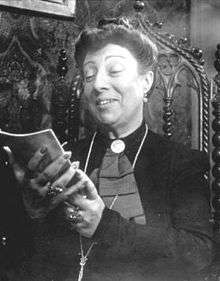Maria Matos
Maria de Conceição de Matos Ferreira da Silva (29 September 1890 – 18 September 1952) was a Portuguese actress and theatre personality.
Maria Matos | |
|---|---|
 | |
| Born | Maria de Conceição de Matos Ferreira da Silva 29 September 1890 |
| Died | 18 September 1952 (aged 61) Lisbon |
Career
Matos studied piano, singing and dramatic art at the Royal Conservatory of Lisbon, and for her final exam performed Rosas de Todo Ano, written by Júlio Dantas.
She debuted professionally at the Teatro Nacional D. Mary II in the play Judas (1907). She married in 1913 the actor Mendonça de Carvalho, who founded the theater company Maria Matos - Mendonça de Carvalho, a company that enjoyed considerable prestige in Portuguese theatre. In 1940, she was appointed at the Conservatório Nacional de Teatro, where she was head of Theatrical aesthetics and Vocal coaching.
Her talent was particularly evident in the farce and the comedy. In the film she starred in successful films such as O Costa do Castelo (1943) and A Menina da Rádio (1944), directed by Arthur Duarte and costarring with António Silva. She also starred in other movies such as As Pupilas do Senhor Reitor (1935), Varanda dos Rouxinóis (1939) by José Leitão de Barros and A Morgadinha dos Canaviais (1949) by Caetano Bonucci and Amadeu Ferrari.
Matos also wrote for A Tia Engrácia, Direitos de Coração and Escola de Mulheres, romantic parts. She died 11 days before her 62nd birthday on 18 September 1952. After her death, her memoirs were published As Memórias da Actriz Maria Matos,[1] and she was honored by having a theatre in Lisbon being called Teatro Maria Matos in 1969.
Personal life
She was the mother of actress Maria Helena Matos (1911 - 2002).
Honours
The Teatro Maria Matos, inaugurated on 22 October 1969, was named in her honour; at its inauguration, artistic director Igrejas Caeiro, presented Tombo no Inferno, by Aquilino Ribeiro in her memory.[2][3]
References
- Memorias / de Maria Matos ; revisao e prefacio de Alice Ogando
- "Missão e História" (in Portuguese). Lisbon, Portugal. 2018. Retrieved 22 August 2018.
- Bandeira, Filomena (2002), SIPA (ed.), Hotel Lutécia / Teatro Municipal Maria Matos (IPA.00011538/PT031106040698) (in Portuguese), Lisbon, Portugal: SIPA – Sistema de Informação para o Património Arquitectónico, retrieved 22 August 2018